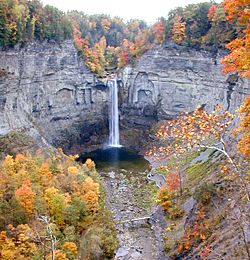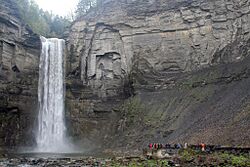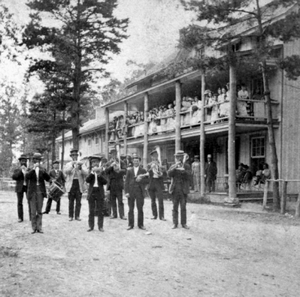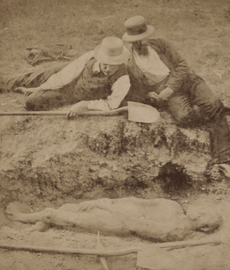Taughannock Falls State Park facts for kids
Quick facts for kids Taughannock Falls State Park |
|
|---|---|

Taughannock Falls in Autumn 2003
|
|
| Lua error in Module:Location_map at line 420: attempt to index field 'wikibase' (a nil value). | |
| Type | State park |
| Location | 1740 Taughannock Blvd. Trumansburg, New York |
| Nearest city | Trumansburg, New York |
| Area | 750 acres (3.0 km2) |
| Created | 1925 |
| Operated by | New York State Office of Parks, Recreation and Historic Preservation |
| Visitors | 434,090 (in 2014) |
| Open | All year |
| Website | Taughannock Falls State Park |
| Taughannock Falls | |
|---|---|

Taughannock Falls in spring 2012
|
|
| Lua error in Module:Infobox_mapframe at line 185: attempt to index field 'wikibase' (a nil value). | |
| Location | Tompkins County, New York |
| Coordinates | 42°32′08″N 76°36′39″W / 42.5356°N 76.6108°W |
| Type | Plunge |
| Total height | 215 ft (66 m) |
| Number of drops | 1 |
| Watercourse | Taughannock Creek |
Taughannock Falls State Park is a large state park in New York State. It covers about 750 acres (3 square kilometers). You can find it near the towns of Trumansburg and Ithaca.
The park is famous for Taughannock Falls. This amazing waterfall drops 215 feet (66 meters). It is the tallest single-drop waterfall east of the Rocky Mountains.
Contents
Park History and Fun Facts
Before the park was created, the land around Taughannock Falls belonged to the Cayuga people. They were a Native American tribe. Later, in the early 1800s, Taughannock Creek powered mills and even a gun factory.
Early Tourism and Hotels
In the late 1800s, many tourists came to see the falls. Steamboats and trains brought visitors to the area. Big Victorian hotels were built to welcome them.
One famous hotel was the Taughannock House. It was built in 1850. Visitors would take a train, then a steamboat, and finally a stagecoach to reach it. Today, the park's visitor center stands where this hotel once was. By 1925, fewer people were visiting. New York State then started buying land to create the state park.
The Taughannock Giant Hoax
In 1879, something strange happened near the Taughannock House Hotel. Workers found what looked like a giant, seven-foot-tall petrified man! Newspapers reported the discovery. Scientists from Cornell University even examined parts of it.
Over 5,000 people paid to see the 800-pound "giant." But soon, it was revealed to be a trick! The hotel owner, John Thompson, and his friends made it. They were inspired by a similar hoax called the Cardiff Giant. Today, the original "giant" is gone, but a copy was made in 2019.
John Thompson also planned another exciting event in 1874. He hired a tightrope walker named "Professor Jenkins." Jenkins walked across a 1,200-foot-long rope. It was suspended 350 feet above the creek! He even crossed it blindfolded.
Becoming a State Park
Taughannock Falls State Park officially opened in 1925. It started with 64 acres (0.26 square kilometers). In the 1930s, the Works Progress Administration improved the park's roads and trails. The park has grown over time to its current size of 750 acres.
What's in a Name?
The name Taughannock has a few possible meanings. All of them come from Native American languages.
- One idea is that it means "great fall in the woods." This combines words from the Iroquois and Algonquin tribes.
- Another idea is that it refers to a Lenni Lenape chief named Taughannock. He may have died near the falls during a battle.
Exploring the Park
Taughannock Falls State Park is a great place for outdoor activities. You can enjoy hiking, nature trails, camping, and picnics.
- The park has a part of Cayuga Lake's shoreline. Here, you can go swimming, fishing, or launch a boat.
- In winter, the park offers ice-skating, sledding, and cross-country skiing.
Besides the main 215-foot Taughannock Falls, there are two other waterfalls.
- The Little or Lower Falls is a 20-foot (6-meter) cascade. It is located downstream from Taughannock Falls.
- The Upper Falls is 100 feet (30 meters) tall. You can find it upstream from Taughannock Falls.
You can see Taughannock Falls from two main trails:
- The Gorge Trail is about 0.75 miles (1.2 kilometers) long. It leads to a viewing area at the base of the falls. This trail also passes by Lower Falls.
- The North Rim Trail (1.5 miles or 2.4 kilometers) and South Rim Trail (1.2 miles or 1.9 kilometers) can be combined. They form a loop hike that offers views of Upper Falls.
The Gorge Trail is open all year. However, the Rim Trails close in winter. For your safety, swimming under the waterfall is not allowed.
About Taughannock Falls
Taughannock Falls is a stunning waterfall. Its main drop is 215 feet (66 meters). This makes it 33 feet (10 meters) taller than Niagara Falls! It is the tallest single-drop waterfall east of the Rocky Mountains. The waterfall is part of Taughannock Creek. This creek flows through a long gorge with cliffs up to 400 feet (122 meters) high.
How the Falls Were Formed
The waterfall and gorge are a great example of a "hanging valley." This happens when a smaller valley (like Taughannock Creek's) meets a much deeper valley. The deeper valley was carved out by glaciers and now holds Cayuga Lake.
The gorge continues to grow wider over time. This is because the creek wears away soft rock called shale at the base of the falls. Harder rock like siltstone and sandstone is above it. Also, freezing and thawing cycles cause pieces of rock to break off. This helps to expand the gorge even more.
The gorge is home to special plants. Some are very rare in New York State. These include Butterwort, birds-eye primrose, and yellow mountain saxifrage.



